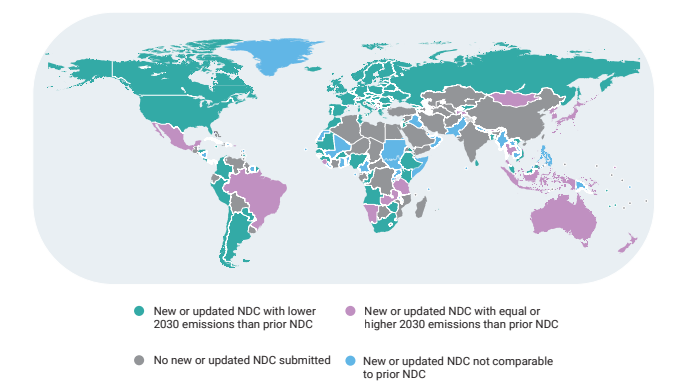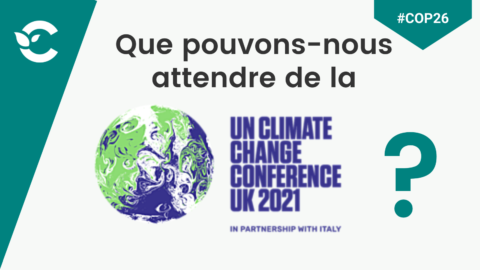This Sunday, October 31, saw the opening of the first week of negotiations of the 26th Conference of the Parties (COP26) between the 197 signatory countries of the Rio Convention (United Nations Framework Convention on Climate Change). After the publication of the sixth assessment report of the IPCC (Intergovernmental Panel on Climate Change) in August, and the presentations of the energy scenarios of RTE and negaWatt for 2050, the COP26 represents a real challenge for States to take action. What are the main objectives of these negotiations?
Secure global net-zero by mid-century and keep 1.5 degrees within reach
The first objective of the discussions is to secure the limit of global warming to 1.5°C in 2100 compared to the pre-industrial era by collecting the different roadmaps of the States. In the UN dialect, these roadmaps are called “Nationally Determined Contribution” (NDC) and define for each State the greenhouse gas emission reduction targets to be reached by 2030. According to the commitments made in the Paris Agreement, the NDCs must be reviewed every 5 years with more ambitious targets than those taken in the previous round. For this first round, these new NDCs should have been submitted to the UN by March 2020. However, to date, only 121 countries, which currently account for about half of global emissions, have submitted their new NDCs. Large emitting countries such as China and India are still missing. The stakes here are very high. The latest United Nations Environment Programme (UNEP) report shows that the current commitments will lead us to +2.7°C warming by the end of the century, compared to the pre-industrial era.

Effect of new or updated Nationally Determined Contributions (NDC) on greenhouse gas emissions in 2030 compared to previous NDCs. Source: UNEP Gap Report 2021
COP26 could be the place to announce new and more ambitious commitments, as was the case for India on November 1st, which announced a carbon neutrality objective for 2070.
Mobilize finance
The second objective is the financing of climate policies. At COP15 in Copenhagen, the developed countries promised to provide developing countries with $100 billion per year by 2020 to meet the climate change challenge. According to the OECD, the funding allocated in 2019 by developed countries and development banks was around 80 billion dollars. According to their estimates, reaching the 100 billion planned is not expected to happen before 2023. The conditions of the debate are very tense at a time when the consequences of climate change are getting more and more felt, especially in countries that bear little responsibility for climate change. This situation is also part of a health crisis in which the relationship of trust between developed and developing countries has been undermined by unfulfilled promises to deliver vaccines.
Work together to deliver
Another important stumbling block concerns the implementation of Article 6 of the Paris Agreement on the establishment of a regulatory framework for a carbon market between States. The objective is to allow countries that emit too much greenhouse gas compared to their NDC to buy carbon credits from countries that emit less than their NDC. The objective is also to create an international carbon market, under the supervision of the UN, accessible to both private and public players, in order to trade carbon credits. The fear, especially in the South, is to de facto authorize the richest actors to pollute and to bet on carbon compensation rather than on emission reduction. The third ambition of Article 6 was also to create a framework for international cooperation between countries in the fight against climate change, not based on the market but rather on international aid mechanisms. The objective of COP26 is to operationalize all of these mechanisms, even though the Katowice and Madrid COPs did not allow negotiators to agree on this point. The debates are mainly focused on the issue of double-counting of avoided emissions, the challenge being to know which of the countries where the emission is made, or the country that buys the carbon credit, can use this reduction to judge its compliance with its NDCs. In particular, Brazil would like to be able to sell its carbon credits while counting them towards its own NDCs. The question is also how to integrate credits from Kyoto Protocol projects into this new system.
Adapt to protect communities and natural habitats
Although the topic of mitigation is the main focus, adaptation to the effects of climate change is also a stated objective of the UK Presidency with an emphasis on nature-based solutions. As we are reminded by the latest IPCC Working Group 1 (Scientific Aspects of the Climate System and Climate Change) report or the increasingly tangible impacts of climate disasters, the topic of adaptation is a central issue for which it is difficult to assess progress or even define a common measurable goal.
Last chance summit for some, probable failure for others, the COP26 is the opportunity for governments to set up concrete progress in the fight against climate change, echoing their various declarations made before the conference, during the G20 weekend of October 30-31 in Rome, Italy. An ambitious COP26 that would respond to the various challenges outlined above would be a strong signal to civil society and economic players, stakeholders who are then the driving force behind the implementation of the low-carbon and energy transition at the national level. Although international climate negotiations are essential to establish a framework within which to evolve, the effects of these negotiations will only be felt if the countries and the various players translate them into concrete territorial policies and business strategies. See you in two weeks to analyze the decisions taken during these intense weeks of negotiations and to try to measure the impact they may have on all the players – private, public, or financial!
To go further:
- COP26 explained by Financial Times
- What to expect from COP26 on climate? by the French independent policy research institute and a multi-stakeholder dialogue platform (IDDRI)
- Emissions Gap Report 2021 by United Nations Environment Programme (UNEP)
- In-depth Q&A: How ‘Article 6’ carbon markets could ‘make or break’ the Paris Agreement by CarbonBrief
Insight is our series of short publications, devoted to helping you further understand today’s important events. Other Insight publications can be found here.



